| FUGUE 1: Birds | 3:11 | |
| FUGUE 2: Insects and paper airplanes (scherzo) | 3:41 | |
| FUGUE 3: Stars | 5:08 | |
| FUGUE 4: Langley (scherzo) | 1:30 | |
| FUGUE 5: Swings | 1:58 | |
| FUGUE 6: Daedalus and Icarus |
5:09 |
String Quartet No. 2: Flight conflates two definitions of the word fugue: the musical composition and the idea of flight itself. Each of the six movements uses fugal procedures; each also focuses on a specific aspect of flying.
flight \ n 1: an act of passing through the air by the use of wings 2: an unrestrained exercise or display of imagination
fugue \ n [fr. Latin: fuga flight] a polyphonic composition in which one or two subjects are imitated by successively entering voices in a continuously interweaving contrapuntal texture
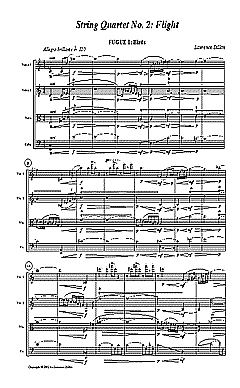 FUGUE 1: Birds
FUGUE 1: Birds
Although many compositions throughout the ages have imitated bird song, the flight of birds has seldom been captured in music. To launch themselves into the air, birds use their leg muscles in conjunction with flapping their wings. On each downstroke, the tips of the wings twist forward while the rest of the wing remains level. Once airborne, most birds alternate the flapping of their wings with soaring, or riding the prevailing air currents.
Creating a musical equivalent to bird flight required a novel approach to fugue-writing. The subject, rather than being played by a single instrument, is a gesture that results from the blending of all four instruments. As the subject passes through different key centers, “countersubjects” are added in the form of solo figures stated by individual instruments.
The natural kinship between a wing and a bow arm finds expression in the coda, in which each instrument relaxes into a gentle swaying motion between two double-stops.
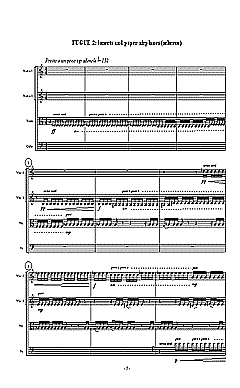 FUGUE 2: Insects and paper airplanes (scherzo)
FUGUE 2: Insects and paper airplanes (scherzo)
The darting, buzzing flight of insects is the subject of this scherzo, which is marked “Very fast and a little obnoxious.” By contrast, the trio section is a whimsical enactment of paper airplane flight: lazy, chaotic, and ultimately doomed. The insects return with renewed fervor, only to be summarily dispatched by the cellist.
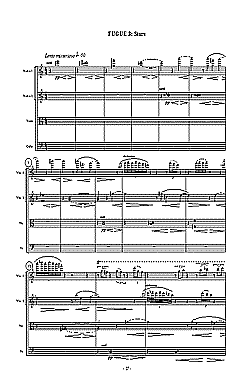 FUGUE 3: Stars
FUGUE 3: Stars
Stars don’t fly in any literal sense of the word, but their gradual emergence and distant traversal of the night sky never fails to promote quiet introspection.
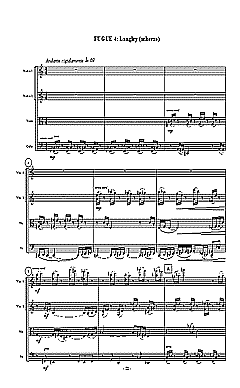 FUGUE 4: Langley (scherzo)
FUGUE 4: Langley (scherzo)
In 1903, the US Army gave Samuel Pierpont Langley an enormous sum of money to build a steam-powered aerodrome. Huge crowds of onlookers and reporters gathered at the launching site: a tall scaffolding mounted on a houseboat. The engine gradually built up tremendous power, creating an increasingly deafening sound — before the aerodrome dropped off its perch and fell straight down into the Potomac River.
A few days later, the Wright brothers made their first successful flight on the North Carolina coast — and nobody noticed.
After a hundred years have gone by, it’s comforting to know that the mismanagement of government funds and the obtuseness of the media are not inventions of our own time.
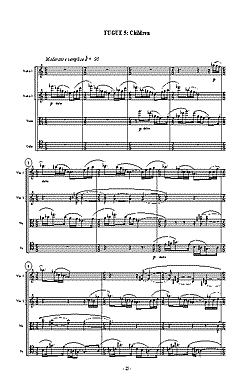 FUGUE 5: Swings
FUGUE 5: Swings
The fifth fugue, an evocation of playground swingsets, is a tribute to flights of fancy, especially the peacefully unselfconscious dreams of children. It segues directly into the sixth and final movement.
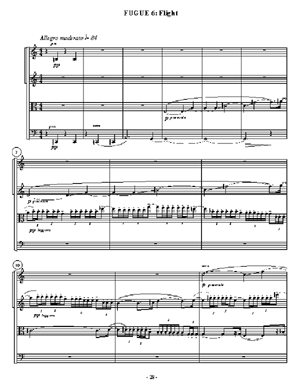 FUGUE 6: Daedalus and Icarus
FUGUE 6: Daedalus and Icarus
The quartet concludes in a double-fugue with contrasting subjects: first Daedalus, the creative muse of flight, followed by Icarus, the ambitious, aggressive manipulator of flight. The movement culminates in a coda inspired by Orville Wright’s tragically uncomprehending words after the first aircraft had been perfected: “This is an invention which will make further wars practically impossible!”
ORDER STRING QUARTET NO. 2: FLIGHT:
- score and parts: American Composers Editions
- recording on Bridge: Daedalus String Quartet